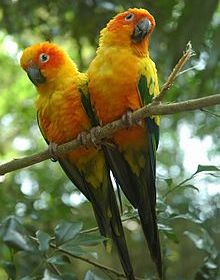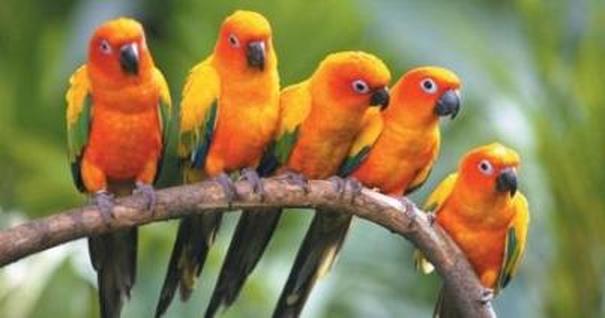Sun ConureAratinga solstitialis |

Custom Search
|
|
The sun conure (Aratinga solstitialis) is a medium-sized brightly colored parrot species found in a relatively small region of northeastern South America. They are natively found in the north Brazilian state of Roraima, extreme southern Suriname, southern Guyana, and southern French Guiana.
It might also be present in Venezuela but this remains unconfirmed. The sun conure's exact habitat requirements remain very poorly known by scientists. Sun conures are found in coastal forests, the edge of humid forests, savanna, and palm grove habitats. Sometimes it's also found in flooded varzea scrub and shrublands along the Amazon riverbanks. They live up to 4000 ft (1200 m) high. The sun conure is a very social bird and in the wild they typically live in flocks of 10 to 30 individuals, rarely leaving their flock. But if they get separated from the flock they will squawk and scream in a high pitch voice which allows them to communicate at quite a distance with their group and return to them. These flocks are normally very quiet when feeding, but are much more vocal when in flight making loud noises. They are fast flyers and are capable of traveling for many miles in a single day.
The sun conure is sexually monomorphic, meaning adults of both sexes are similar in appearance. However, males usually have slightly longer and rounder tail feathers and slightly bigger heads.
Their adult plumage is predominantly golden-yellow with orange in the face and belly and red around the ears.The sun conure tail is an olive-green color with a blue tip. They have a black bill, bare legs and a grey eye-ring which often fades to white while in captivity. Young and juvenile specimens show a predominantly dull green color plumage, the sun conure's distinctive yellow, orange, and reddish colour on the back, abdomen, and head is attained as they mature. This duller coloration serves as a defense mechanism in the wild by providing younglings with extra camouflage. The sun conure averages approximately 4 oz (110 g) in weight and measure around 12 inches (30 cm), with a wingspan of 146 to 162 cm. Subspecies There are no subspecies currently recognized by scientists, the Jenday Conure (Aratinga jandaya) is at times considered a subspecies of the sun conure. Diet / Feeding The sun conure diet in the wild is very poorly documented. But in the wild, they feed mostly on fruits, flowers, berries, buds, blossoms, seeds, nuts and insects. Occasionally they forage from agricultural crops and are therefore sometimes considered pests. During breeding season they will need more proteins, more carbohydrates when rearing young and more calcium for females during egg production. They use their feet like little hands to help them hold, examine, or eat food. Reproduction The sun conure forms a monogamous pair at the very young age of about 4 to 5 months. The breeding season usually begins in the spring and prior to breeding the pair may be seen feeding and grooming each other. Before the female lays the eggs their abdomen swells quite noticeably. They nest in trees or palm cavities and the eggs measure about 1.12 x 0.90 inches. Their fertility rate is considered relatively high, with the average clutch containing 2 to 5 eggs which may be laid in a 2 to 3 day interval. They are then incubated for a period of 23 to 27 days, this is handled entirely by the female which leaves the nest only for short periods to feed. While the male will aggressively protect the nest from any nearby predators. Sometimes the eggs may fail to hatch and occasionally the parents may eat their own eggs if they have a calcium deficiency. It may take anywhere from a few hours to a couple of days for the chicks to break through the egg shell. The chicks are born blind, naked and completely vulnerable, only after about 10 days do they open their eyes. Both parents will help feeding the chicks after hatching, the young birds are dependent on their parents for 7 to 8 weeks becoming independent after 9 to 10 weeks. The sun conure becomes sexually mature at about 2 years of age and live 25 to 30 years. Conservation status and major threats While in the past the sun conure was listed as Least Concern the latest surveys taken in recent years lead to the species being uplisted to Endangered by the IUCN Red List in 2008. The sun conure is listed in CITES Appendix II. These birds are hunted and collected from the wild for their beautiful plumage, with about 800,000 each year being exported for the pet trade. Combined with habitat loss their population numbers in the wild are declining very rapidly, and it's believed that today there are more sun conures in captivity than in the wild. Today they are considered extirpated in southern Guyana where it was previously regarded as common, has become rare in the Brazilian state of Roraima, and it's also considered very rare in French Guiana. To try and counteract these negative effects both the US and the European Union banned the importation of parrots and other wild caught birds. For that reason nowadays the sun conure is now more frequently breed in captivity. However the collection of wild individuals is still a potential threat, since they are easily attracted to bait and and group roosting behaviour making them very easy to capture in large numbers.
|
Scientific classification
Kingdom: Animalia Phylum: Chordata Class: Aves Order: Psittaciformes Superfamily: Psittacoidea Family: Psittacidae Subfamily: Arinae Tribe: Arini Genus: Aratinga Species: A. solstitialis |



